Abstract
Aiming to develop low-cost Mg alloys with good mechanical properties, a new Mg-6Bi-3Al-1Zn (wt.%, BAZ631) alloy having a high ultimate tensile strength of ~402 MPa and an elongation of ~15% was fabricated by single pass extrusion. The as-extruded BAZ631 alloy demonstrates an almost fully dynamic recrystallized microstructure with an average grain size of ~2.9 μm. Moreover, both nano-scale Mg3Bi2 and Mg17Al12 precipitates were found dispersed in the matrix. These excellent mechanical properties are attributed to the combined effects of grain boundary strengthening, dispersion and precipitation strengthening induced by both micro and nanoscale second phase particles, and solid-solution strengthening. This high strength and good ductile Mg-Bi based alloy without rare-earth elements addition is expected to inspire a new alloy design strategy for fabricating high performance Mg products for larger-scale industrial applications.
1. Introduction
Application magnesium (Mg) alloys in the transportation industry is attracting increasing attention these years due to their high specific strength [1,2]. However, the mechanical properties of commercial high-strength Mg alloys such as AZ80 and ZK60 are still much lower than that of aluminum (Al) alloys such as 2024 and 7075 [3]. Therefore, further improving the mechanical properties of Mg alloys is of great significance in becoming a commercially viable alternative to Al alloys.
In this respect, Mg-Bi-based alloys, based on a typical precipitation-type phase equilibrium, are desirable candidates in developing low-cost high-strength extrudable materials without rare-earth elements (RE) [2,4]. In addition, the Bi element is non-toxic and is called “green metal” [5], the price of which is much lower than that of RE. Therefore, alloying Mg with Bi also has great potential in biomedical applications [6]. Recently, several Mg-Bi-based alloys exhibiting attractive mechanical properties have been fabricated. It is reported that alloying Mg with 3–8 wt.% Bi can greatly enhance the strength of the extruded Mg alloys due to the grain refinement and precipitation strengthening by micro and nanoscale Mg3Bi2 phases [7,8]. Compared with pure Mg, the as-extruded Mg–6Bi(wt.%, B6 all compositions quoted in this work are in wt.%) alloy demonstrates greatly improved strength and ductility with ultimate tensile strength (UTS) of 228 MPa and an elongation (EL) of 19.9% [7]. H. Somekawa et al. [9] reported that Mg-3Bi alloy can be extruded at the temperature less than 210 °C and demonstrates an EL of 170%. Additionally, Ca [10,11,12,13,14], Si [10], Mn [15], Al [16], Zn [16], and Sn [17] have been used as alloying elements to improve the mechanical properties of Mg-Bi based alloys. For example, biomedical Mg-5Bi-1Ca/Si alloys having an EL of over 40% were successfully fabricated by the rapid solidification and extrusion process [10]. Based on this study, our former studies [11,12] further found that dilute Ca addition in as-extruded Mg-1.5Bi alloy will introduce weakened <2–1–12>//ED texture and greatly increase its ductility. Additionally, medium strength Mg-8Bi-1Al-1Zn (BAZ811) alloy with UTS of 331 MPa and an EL of 14.6% were fabricated by extrusion in our former research [16]. By combining extrusion and 3-pass caliber rolling processing, a high strength Mg-1.32Bi-0.72Ca (BX11) alloy with a UTS of 381 MPa and an EL of 13.2% was fabricated [14]. More recently, alloying the Mg-Bi alloy with Sn was also used to further increase its mechanical properties, but the UTS of as-extruded Mg-5Bi-6Sn alloy having a typical basic fiber texture and partial dynamic recrystallization (DRX) microstructure is only 301 MPa [17]. Until now, the UTS of all the Mg-Bi based alloys processed by extrusion is still less than 390 MPa, which is much lower than that of Al alloys and steel, and thus the strength of Mg-Bi based alloys needs to be improved urgently.
In order to explore the strengthening and toughening potential of low-cost Mg-Bi based extrusion alloys, we designed a new RE-free Mg-6Bi-3Al-1Zn alloy based on the good combination of strength and ductility of as-extruded Mg–6Bi alloy [7]. The addition of Zn and Al is usually known to improve the mechanical properties of Mg-Bi alloys by enhancing the precipitation response and the solution hardening effect [16]. Therefore, in this study, an experimental RE-free Mg-6Bi-3Al-1Zn alloy was fabricated by single pass extrusion, and its microstructure evolution and mechanical properties were analyzed in detail.
2. Materials and Methods
The alloy ingot with a designed composition of Mg-6Bi-3Al-1Zn (denoted as BAZ631) was fabricated by melting high purity Mg, Bi, Al, and Zn in a crucible resistance furnace (Tongda Furnace, Tianjin, China) and gravity casting. The analyzed composition was confirmed as Mg-6.3Bi-3.1Al-1.1 Zn by inductively coupled plasma (ICP), which is consistent with the nominal composition. Based on the homogenization and extrusion parameters of Mg-Bi binary alloys [7,8], BAZ811 alloy, and AZ31 alloy [15] in our previous studies, the as-cast BAZ631 alloy with a dimension of Ø60 mm × 150 mm was homogenized at 450 °C for 5 h, and then directly extruded at 300 °C with an extrusion ratio of 36:1 at a ram speed of 1.1 mm/s using a horizontal extrusion press with a capacity of 300T (HJY-300T, Wuxi, China). Microstructure characterization was conducted by the Olympus BX51M optical microscope (OM, OLYMPUS, Shanghai, China), scanning electron microscopy (SEM, JEOL JSM-7000F, JEOL, Tokyo, Japan) and energy dispersive spectrometer (EDS). The specimens for the OM and SEM microscopy were polished and etched using a solution of 10 mL acetic acid + 4.2 g picric acid + 70 mL ethanol + 10 mL distilled water. The average grain size (AGS) of the as-homogenized and as-extruded BAZ631 samples was determined using the linear intercept method in homogenized OM pictures and as-extruded SEM images, respectively. Moreover, the volume fraction of undissolved micro-scale second phase (Vfμ) in homogenized OM pictures was measured using Image-Pro Plus 6.0 software. The Bruker D8 Focus (Karlsruhe, Germany) was used to conduct X-ray diffraction (XRD) analysis in order to figure out the phase in the as-homogenized specimen. The precipitation behavior of as-extruded BAZ631 alloy was revealed by a transmission electron microscope (TEM, JEM 2100F, JEOL, Tokyo, Japan) equipped with energy-dispersive X-ray spectroscopy (EDX). Finally, the gauge dimension of the specimens for tensile tests had a diameter of 6 mm and a length of 25 mm. The tensile tests along the extrusion direction (ED) were carried out using the SUNS-UTM5105X mechanical testing machine (Shenzhen Suns Technology Stock Co., Ltd., Shenzhen, China) at room temperature with a strain rate of 1 × 10−3 s−1.
3. Results and Discussion
Figure 1 shows the OM and SEM microstructures of the as-homogenized BAZ631 alloys. The AGS of the as-homogenized BAZ631 sample is 55 ± 5 μm, which is finer than that of homogenized BAZ811 (AGS, ~70 μm) [16]. Moreover, there are some sphere-like and rod-like second phases ranging in size from 1 μm to 20 μm still maintained in the grain interior or along the grain boundaries, as shown in Figure 1b–d. In order to clarify these intermetallic compounds, EDS analyses were carried out, as presented in Figure 1e,f. The typical EDS spectrum taken from the particles and α-Mg matrix of homogenized BAZ631 indicates that the second phase consists of Mg and Bi and that the α-Mg matrix consists of Mg, Bi, Al, and Zn, respectively. As shown in Figure 2, the peaks arising from α-Mg and Mg3Bi2 phases (hcp, a = 0.4666 nm, c = 0.7401 nm) are clearly identified in the diffraction patterns of homogenized BAZ631 alloy. Therefore, it can be concluded that the major micro-scale phase remaining in the homogenized BAZ631 alloy is Mg3Bi2, demonstrating its relatively good thermal stability at the homogenization temperature of 450 °C. However, there are no peaks from phases containing Al and Zn in the X-ray diffraction spectra of the as-homogenized BAZ631 sample. This is because 3% Al and 1% Zn were all dissolved into the α-Mg matrix when homogenized at 450 °C for 5 h considering their large solid solubility in Mg at a homogenization temperature of 450 °C, which is consistent with our former research [16]. Moreover, the total volume fraction of second phases in homogenized BAZ631 is ~5.3%, a little lower than that of the homogenized BAZ811 sample due to the lower Bi addition in BAZ631.
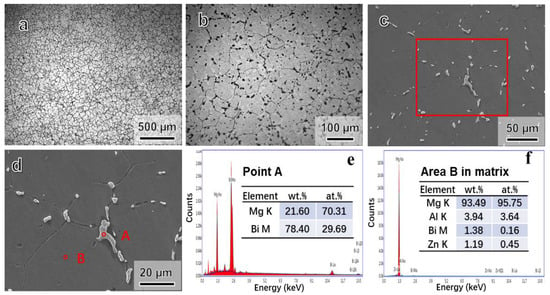
Figure 1.
OM (a,b), SEM (c,d) micrographs, and EDS results (e,f) of as-homogenized BAZ631 alloy.
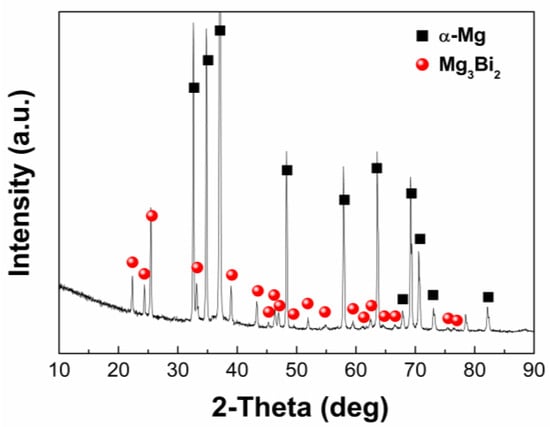
Figure 2.
X-ray diffraction spectra of as-homogenized BAZ631 alloy at 450 °C for 5 h.
Figure 3 indicates OM and SEM images taken of longitudinal sections of the as-extruded BAZ631 alloy. The as-extruded BAZ631 sample exhibits a homogeneous microstructure which is almost fully dynamic recrystallized (DRXed), as presented in Figure 3a,b. Compared with the homogenized sample, the DRXed microstructure of the extruded sample has been greatly refined with an AGS of 2.9 ± 0.4 μm, clearly presented in Figure 3c,d. Moreover, the micron Mg3Bi2 strips and broken particles (Figure 3b,c) distributed along the ED, which is original from insoluble Mg3Bi2 phase particles in homogenized microstructure (Figure 1). In particular, as shown in Figure 3d, high magnification SEM image of the as-extruded BAZ631 specimen suggests numerous fine intermetallic particles, which were not detected in the as-homogenized sample, demonstrating that dynamic precipitation happened during extrusion.
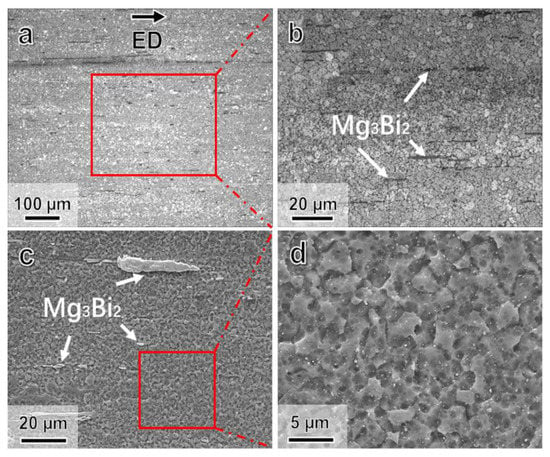
Figure 3.
OM (a,b) and SEM (c,d) micrographs of as-extruded BAZ631 alloy; ED: extrusion direction.
In order to elucidate the precipitation behavior of BAZ631 alloy during extrusion, TEM characterization was conducted, and the corresponding results are presented in Figure 4. Both micro-scale second phase and ultra-fine precipitates dispersed in the fine DRXed matrix, which well agreed with the OM and SEM observations. The most distinctive feature of the TEM microstructures is that abundant nano-scale globular particles with a size varying from 50–200 nm are distributed both at grain boundaries (GBs) and within grain interiors. Most of the nano-scale particles were further identified as Mg3Bi2 by the selected area diffraction pattern (SADP) (Figure 4d). In addition, some fine Mg17Al12 precipitates were also identified according to the results of SADP in Figure 4e, which is quite different with the as-extruded BAZ811 alloy only containing Mg3Bi2 precipitates. The distribution of these fine Mg3Bi2 particles both at GBs and within grain interiors indicates that dynamic precipitation occurred during high-speed extrusion at 300 °C, which is well agreed with recent research on low-speed extruded Mg-Bi binary alloys [7,8] and high-speed extruded Mg-Bi-Al alloy [18,19]. As a typical precipitation-hardenable Mg alloy system, the solubility of Bi in Mg at the homogenization treatment temperature (450 °C) in this study is about 5 wt.%, which decreases nearly to 0 wt.% at extrusion temperature (300 °C) [4,7]. The plastic deformation during high-speed extrusion can introduce dislocation tangles, providing nucleation sites for the Mg3Bi2 precipitation in Mg-Bi binary alloys. In particular, there are also ultra-fine DRXed grains with a size of ~300 nm in the as-extruded BAZ631 alloy together with globular particles at its GBs, as presented in Figure 4b,c. In addition, some micro-scale Mg3Bi2 particles were also observed in the BAZ631 alloy (Figure 4a), consistent with the above OM and SEM observations. Furthermore, the AGS of the BAZ631 alloy is only 0.3–3 µm, which is smaller than that of Mg-6Bi (B6) extruded under similar conditions [7], demonstrating that 3 wt.% Al and 1 wt.% Zn addition can further refine the microstructure.
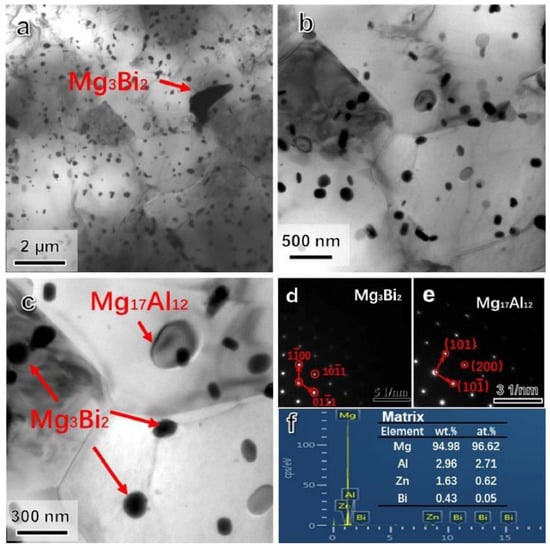
Figure 4.
TEM images of as-extruded BAZ631 alloy at low (a) and high (b,c) magnification, selected area diffraction patterns of (d) Mg3Bi2 and (e) Mg17Al12 precipitates and (f) EDX analysis of matrix.
Generally, the size, spacing, and fraction of second particles in the BAZ631 alloy can either promote or hinder DRX in various circumstances during extrusion [20,21,22]. There are both ultra-fine Mg3Bi2 precipitates and micro-scale Mg3Bi2 particles in the BAZ631 sample. It is believed that the undissolved particles having a size larger than 1 µm can act as nucleation sites for DRX by generating local inhomogeneity in strain energy during hot extrusion, which is well-known as Particle-Stimulated Nucleation (PSN) [23]. Moreover, the smaller initial grain size of the BAZ631 alloy is also likely to increase the DRX fraction compared with the BAZ811 alloy due to the higher density of grain boundary nucleation sites [16]. This may be the two reasons why almost fully DRXed microstructure was obtained in the as-extruded BAZ631 alloy. The ultra-fine Mg3Bi2 precipitates (<1 µm) are well known to substantially retard DRX by greatly reducing the mobility of grain boundaries and inhibiting boundary bulging required for the nucleation of new DRXed grains during hot extrusion, which is referred to as the Zener pinning effect [24]. The ultra-fine Mg3Bi2 and Mg17Al12 precipitates in the BAZ631 alloy will inhibit the growth of DRXed grains through the grain-boundary pinning effect, thereby resulting in considerable grain refinement of the DRXed grains, causing the formation of ultra-fine grains in as-extruded BAZ631 (Figure 4b,c).
The mechanical properties including tensile yield strength (TYS), UTS and EL of extruded BAZ631 alloy are summarized in Table 1 and their typical tensile stress-strain curves were represented in Figure 5, compared with B6 and BAZ811 alloys extruded under the similar conditions. The as-extruded BAZ631 alloy shows a UTS of 402 ± 4 MPa and an acceptable elongation of 15.2 ± 0.4%. The UTS of the BAZ631 sample is much higher than that of B6 [7], and even higher than that of the more Bi concentrated BAZ811 sample [16]. The RE-free BAZ631 alloy by simple one-step extrusion in this study shows much higher UTS than that of Mg-Bi-Ca alloy processed by combining extrusion and caliber rolling [14], which ranks first among all the previously reported Mg-Bi-based alloys until now. It is widely accepted that the microstructure characteristics, such as AGS, second phase particles, and solute atoms in the Mg alloys, significantly affect their mechanical properties. Based on the above microstructure characterization results, the fine and ultra-fine DRXed grains in the BAZ631 alloy can significantly contribute to the high strength according to the Hall–Petch relationship [7,25]. The abundant ultra-fine Mg3Bi2 and Mg17Al12 precipitates, micro-sized Mg3Bi2 particles, and dissolved solute atoms (about 3 wt.% Al and 1 wt.% Zn) should also contribute to the resultant high strength. Furthermore, extruded BAZ631 alloys also have good ductility with an EL of more than 15% compared with the newly developed ultra-high-strength Mg-2Sn-2Caalloy [26], the BAZ631 alloy shows much longer elongation and comparable ultra-high strength. The RE-free alloying method, and the simple one-step extrusion, are expected to inspire a new alloy design strategy for fabricating high performance Mg products for larger-scale industrial applications.

Table 1.
Microstructural characteristics and tensile properties of extruded BAZ631 alloy, compared with B6 and BAZ811.
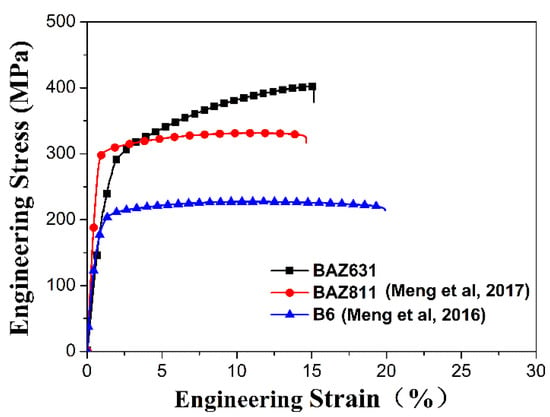
Figure 5.
Typical tensile stress-strain curves of as-extruded BAZ631 alloy, compared with B6 and BAZ811 [7,16].
4. Conclusions
In summary, aiming to develop low-cost Mg alloys with good mechanical properties, an extraordinary high-strength RE-free BAZ631 alloy with a UTS of ~402 MPa and an EL of ~15% was successfully fabricated by one-step extrusion. The RE-free alloying strategy will inspire a new alloy design strategy for fabricating high-performance Mg products. Moreover, the ultra-fine Mg3Bi2 and Mg17Al12 precipitates were identified dispersed on the DRXed α-Mg matrix with an average grain size of 2.9 ± 0.4 μm. The good tensile property originated from the combined effects of grain boundary strengthening, dispersion, and precipitation and solid-solution strengthening. Furthermore, the effects of Mg3Bi2 and Mg17Al12 particles on DRX behavior were also revealed, which provide inspiration for microstructure control of extruded Mg-Bi based alloys.
Author Contributions
Methodology, S.M., H.X. and Z.L.; data curation, S.M., H.X. and M.Z.; writing—original draft preparation, S.M.; writing—review and editing, S.M., H.X., Z.L., R.J., X.C. and H.Y.; supervision, S.M. and H.Y.; project administration, S.M.; funding acquisition, S.M. All authors have read and agreed to the published version of the manuscript.
Funding
This work was supported by the Gansu Province Science and Technology Foundation for Youths (Grant No. 21JR7RA261), Innovation Fund Project for Universities in Gansu Province (Grant No. 2022A-025), the Project funded by China Postdoctoral Science Foundation (Grant No. 2022M713656), the Graduate Student Outstanding Innovation Project of Hebei Province (CXZZBS2018030) and the Tamarisk Outstanding Young Talents Program of Lanzhou University of Technology.
Institutional Review Board Statement
Not applicable.
Informed Consent Statement
Not applicable.
Data Availability Statement
Not applicable.
Conflicts of Interest
The authors declare no conflict of interest.
References
- Bettles, C.; Gibson, M. Current wrought magnesium alloys: Strengths and weaknesses. JOM 2005, 57, 46–49. [Google Scholar] [CrossRef]
- Meng, S.; Yu, H.; Fan, S.; Li, Q.; Park, S.H.; Suh, J.S.; Kim, Y.M.; Nan, X.; Bian, M.; Yin, F.; et al. Recent Progress and Development in Extrusion of Rare Earth Free Mg Alloys: A Review. Acta Metall. Sin-Engl. 2019, 32, 145–168. [Google Scholar] [CrossRef] [Green Version]
- ASM Handbook Committee. Properties and Selection: Nonferrous Alloys and Special Purpose Materials, 10th ed.; ASM International: Materials Park, OH, USA, 1990; Volume 2. [Google Scholar]
- Nie, J.-F. Precipitation and Hardening in Magnesium Alloys. Metall. Mat. Trans. A 2012, 43, 3891–3939. [Google Scholar] [CrossRef] [Green Version]
- Mohan, R. Green bismuth. Nat. Chem. 2010, 2, 336. [Google Scholar] [CrossRef]
- Mirco, P.; Christian, S.P.; Alberto, F.; Alessandra, V.; Roberto, M.; Hans, J.R.; Paolo, F.; Filippo, B.; Jan, T. The effect of Equal Channel Angular Pressing on the stress corrosion cracking susceptibility of AZ31 alloy in simulated body fluid. J. Mech. Behav. Biomed. 2020, 106, 103724. [Google Scholar]
- Meng, S.J.; Yu, H.; Cui, H.X.; Wang, Z.F.; Zhao, W.M. Microstructure and mechanical properties of extruded pure Mg with Bi addition. Acta Metall. Sin. 2016, 52, 811–820. [Google Scholar]
- Yu, H.; Fan, S.; Meng, S.; Choi, J.O.; Li, Z.; Go, Y.; Kim, Y.M.; Zhao, W.; You, B.S.; Shin, K.S. Microstructural evolution and mechanical properties of binary Mg-xBi (x = 2, 5, and 8 wt%) alloys. J. Magnes. Alloys 2021, 9, 983–994. [Google Scholar] [CrossRef]
- Somekawa, H.; Sing, A. Superior room temperature ductility of magnesium dilute binary alloy via grain boundary sliding. Scr. Mater. 2018, 150, 26–30. [Google Scholar] [CrossRef]
- Remennika, S.; Bartschb, I.; EWillbold, E.; Witte, F.; Shechtman, D. New, fast corroding high ductility Mg-Bi-Ca and Mg-Bi-Si alloys, with no clinically observable gas formation in bone implants. Mater. Sci. Eng. B 2011, 176, 1653–1659. [Google Scholar] [CrossRef]
- Meng, S.; Yu, H.; Fan, S.; Kim, Y.M.; Park, S.H.; Zhao, W.; You, B.S.; Shin, K.S. A high-ductility extruded Mg-Bi-Ca alloy. Mater. Lett. 2020, 261, 127066. [Google Scholar] [CrossRef]
- Meng, S.; Yu, H.; Li, L.; Qin, J.; Woo, S.K.; Go, Y.; Kim, Y.M.; Park, S.H.; Zhao, W.; Yin, F.; et al. Effects of Ca addition on the microstructures and mechanical properties of as-extruded Mg–Bi alloys. J. Alloys Compd. 2020, 834, 155216. [Google Scholar] [CrossRef]
- Liu, Y.; Cheng, W.; Zhang, Y.; Niu, X.; Wang, H.; Wang, L. Microstructure, tensile properties, and corrosion resistance of extruded Mg-1Bi-1Zn alloy: The influence of minor Ca addition. J. Alloy. Compd. 2020, 815, 152414. [Google Scholar] [CrossRef]
- Meng, S.; Yu, H.; Han, H.; Feng, J.; Huang, L.; Dong, L.; Nan, X.; Li, Z.; Park, S.H.; Zhao, W. Effect of Multi-Pass Caliber Rolling on Dilute Extruded Mg-Bi-Ca Alloy. Metals 2020, 10, 332. [Google Scholar] [CrossRef] [Green Version]
- Wang, Q.H.; Zhai, H.W.; Liu, L.T.; Xia, H.B.; Jiang, B.; Zhao, J.; Chen, D.L.; Pan, F.S. Novel Mg-Bi-Mn wrought alloys: The effects of extrusion temperature and Mn addition on their microstructures and mechanical properties. J. Magnes. Alloys 2021, in press. [Google Scholar] [CrossRef]
- Meng, S.; Yu, H.; Zhang, H.; Cui, H.; Park, S.H.; Zhao, W.; You, B.S. Microstructure and mechanical properties of an extruded Mg-8Bi-1Al-1Zn (wt.%) alloy. Mat. Sci. Eng. A 2017, 690, 80–87. [Google Scholar] [CrossRef]
- Jin, S.-C.; Lee, J.U.; Go, J.; Yu, H.; Park, S.H. Effects of Sn addition on the microstructure and mechanical properties of extruded Mg-Bi binary alloy. J. Magnes. Alloys 2022, 10, 850–861. [Google Scholar] [CrossRef]
- Go, J.; Jin, S.C.; Kim, H.; Yu, H.; Park, S.H. Novel Mg-Bi-Al alloy with extraordinary extrudability and high strength. J. Alloys Compd. 2020, 843, 156026. [Google Scholar] [CrossRef]
- Cha, J.W.; Jin, S.C.; Jung, J.G.; Park, S.H. Effects of homogenization temperature on microstructure and mechanical properties of high-speed-extruded Mg-5Bi-3Al alloy. J. Magnes. Alloys 2021, in press. [Google Scholar] [CrossRef]
- Doherty, R.D.; Hughes, D.A.; Humphreys, F.J.; Jonas, J.J.; Jensen, D.J.; Kassner, M.E.; King, W.E.; Mcnelley, T.R.; Mcqueen, H.J.; Rollett, A.D. Current issues in recrystallization: A review. Mat. Sci. Eng. A 1997, 238, 219–274. [Google Scholar] [CrossRef] [Green Version]
- Zhou, H.; Huang, C.X.; Sha, X.C.; Xiao, L.R.; Ma, X.L.; Hoppel, H.W.; Goken, M.; Wu, X.L.; Ameyama, K.; Han, X.D.; et al. In-situ observation of dislocation dynamics near heterostructured interfaces. Mater. Res. Lett. 2019, 7, 376–382. [Google Scholar] [CrossRef] [Green Version]
- Meng, S.; Dong, L.; Yu, H.; Huang, L.; Han, H.; Cheng, W.; Feng, J.; Wen, J.; Li, Z.; Zhao, W. New Ultra-High-Strength AB83 Alloy by Combining Extrusion and Caliber Rolling. Materials 2020, 13, 709. [Google Scholar] [CrossRef] [PubMed] [Green Version]
- Robson, J.D.; Henry, D.T.; Davis, B. Particle effects on recrystallization in magnesium-manganese alloys: Particle-stimulated nucleation. Acta Mater. 2009, 57, 2739–2747. [Google Scholar] [CrossRef]
- Huang, K.; Logé, R.E. A review of dynamic recrystallization phenomena in metallic materials. Mater. Des. 2016, 111, 548–574. [Google Scholar] [CrossRef]
- Wang, Y.N.; Huang, J.C. Grain Size Dependence of Yield Strength in Randomly Textured Mg-Al-Zn Alloy. Mater. Trans. 2007, 48, 184–188. [Google Scholar] [CrossRef] [Green Version]
- Pan, H.; Qin, G.; Huang, Y.; Ren, Y.; Sha, X.; Han, X.; Liu, Z.-Q.; Li, C.; Wu, X.; Chen, H.; et al. Development of low-alloyed and rare-earth-free magnesium alloys having ultra-high strength. Acta Mater. 2018, 149, 350–363. [Google Scholar] [CrossRef] [Green Version]
Publisher’s Note: MDPI stays neutral with regard to jurisdictional claims in published maps and institutional affiliations. |
© 2022 by the authors. Licensee MDPI, Basel, Switzerland. This article is an open access article distributed under the terms and conditions of the Creative Commons Attribution (CC BY) license (https://creativecommons.org/licenses/by/4.0/).